
Rain Gardens: Beautiful Solutions for Stormwater Management
Published: 25/06/2025 | Updated: 25/06/2025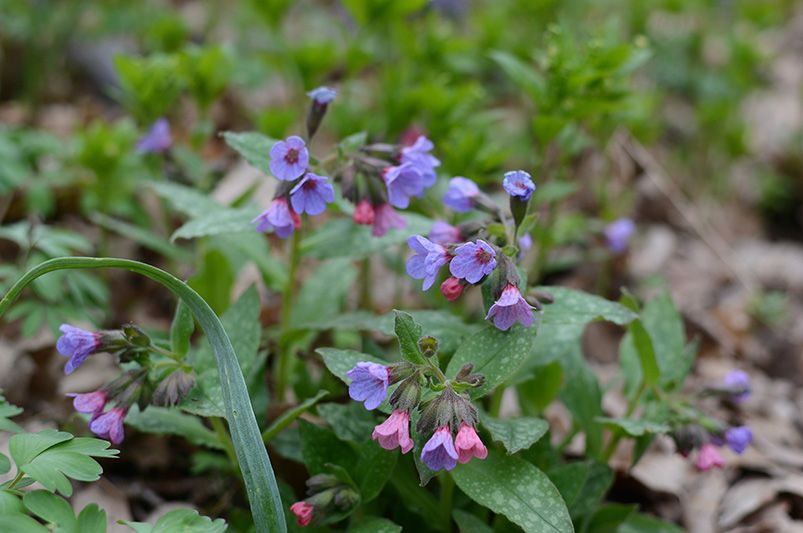
Looking for a beautiful and eco-friendly way to manage stormwater in your yard? A rain garden might be the perfect solution. These shallow, landscaped basins are specially designed to capture and absorb rainwater runoff from hard surfaces like rooftops, driveways, patios, and sidewalks. By slowing the flow of water and allowing it to soak into the ground, rain gardens help reduce flooding, prevent erosion, and naturally filter out pollutants—ultimately improving the quality of nearby waterways. Planted with a mix of native flowers, grasses, and shrubs, rain gardens not only support local wildlife and pollinators but also add year-round beauty and function to your outdoor space.


Why Rain Gardens Matter: The Environmental Benefits
-
Reduces Soil Erosion: By slowing down and absorbing runoff, rain gardens prevent soil from washing away and protect surrounding structures and plants.
-
Filters Pollutants: Rain gardens act as natural filtration systems, trapping chemicals, debris, and sediments before they reach streams and waterways.
-
Supports Local Ecosystems: Properly planted rain gardens provide essential habitat for pollinators like bees and butterflies, as well as beneficial insects and birds.
-
Replenishes Groundwater: Instead of losing valuable rainwater to storm drains, rain gardens help recharge the soil, promoting healthier landscapes.
The Aesthetic Appeal
Rain gardens aren’t just functional—they’re beautiful. With the right plant selections, they can become a stunning focal point in any yard, blending effortlessly into both modern minimalist and classic traditional garden styles. Whether framed by ornamental grasses, punctuated with colorful perennials, or softened with ground covers, rain gardens bring texture, color, and dynamic seasonal interest to your outdoor space.
ShrubHub Tip: Our 3D custom landscape designs can seamlessly incorporate rain gardens that not only manage water effectively but also complement your unique garden style and property layout.
How to Design an Effective Rain Garden
Designing a rain garden isn’t just about digging a hole and planting a few flowers—it’s about strategically managing water while enhancing your landscape’s beauty. With thoughtful planning, your rain garden can become both a functional stormwater solution and a stunning garden feature.
1. Site Selection: Work with the Water Flow
Start by observing where water naturally collects on your property.
Ideal spots include:
-
Low-lying areas
-
The base of downspouts
-
The edges of driveways or patios
Avoid placing rain gardens too close to building foundations or in areas with poor drainage that might hold standing water long-term.
2. Soil Preparation: Encourage Absorption
Rain gardens require well-drained soil to absorb water efficiently.
Steps to prepare your site:
-
Remove compacted soil and debris
-
Add sand, compost, or a specialized rain garden soil mix to improve drainage
-
Ensure the garden has a slight slope to direct runoff properly into the planting zone
3. Smart Plant Layering: Plan by Moisture Zones
The secret to a thriving rain garden is using moisture zones effectively:
-
Center Zone (Wettest): Choose plants that can handle standing water for short periods.
-
Middle Zone (Moderate Moisture): Select plants that thrive in moist but not saturated soil.
-
Outer Zone (Driest): Opt for drought-tolerant plants that manage occasional runoff.
Native plants with deep root systems are ideal, as they help absorb water quickly and prevent erosion.
4. Optional Features: Add Functional Beauty
Rain gardens can be as simple or as stylish as you like.
Consider enhancing yours with:
-
Decorative edging to define the space
-
River rocks or gravel channels to guide water flow
-
Overflow zones to manage heavy rainfall safely
ShrubHub Tip: Not sure how big your rain garden should be or which plants to choose? Our custom 3D design services can help you calculate the right dimensions, select the perfect plant mix, and ensure your rain garden integrates beautifully with your overall landscape.
Best Plants for Rain Gardens
Choosing the right plants is essential for a successful rain garden. You’ll want to focus on native, water-tolerant species that can handle both occasional flooding and dry spells. These plants are typically low-maintenance, resilient, and offer seasonal color and texture while supporting local pollinators and wildlife.
Our Top Plant Picks for Rain Gardens:
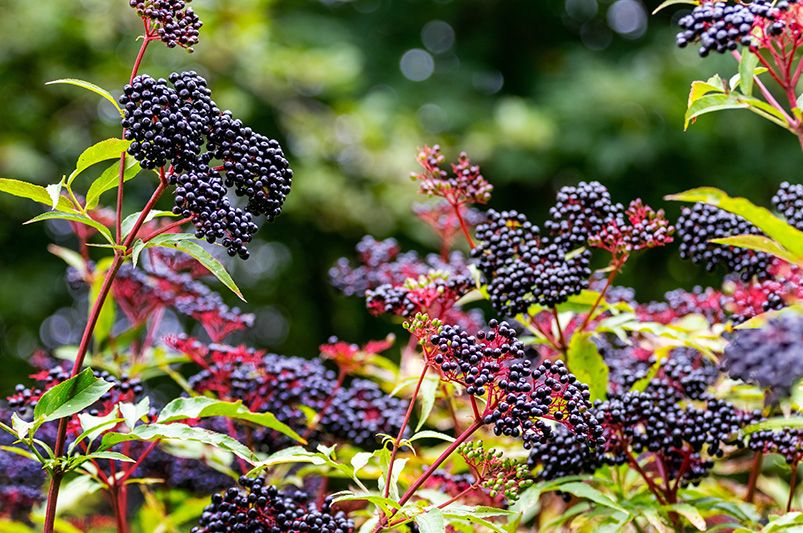
Elderberry
The elderberry plant is a versatile, moisture-loving shrub that thrives in the conditions a rain garden provides. With its lush green foliage, fragrant white flower clusters in spring, and deep purple-black berries in late summer, elderberry adds beauty and seasonal interest to any landscape. Its dense root system helps stabilize soil and reduce erosion, while its natural affinity for wet or periodically saturated soil makes it a perfect fit for rain garden environments. In addition to its ornamental appeal, elderberry supports local wildlife by attracting pollinators and providing nutritious berries for birds. Easy to grow and highly adaptable, it’s both a practical and attractive choice for sustainable, eco-friendly landscaping.

Chokeberry
Chokeberry, also known as Aronia, is an ideal plant for rain gardens thanks to its resilience, beauty, and ecological benefits. This hardy native shrub flourishes in moist, well-drained soils and can tolerate both wet and dry conditions—making it perfectly suited for the fluctuating moisture levels of a rain garden. In spring, it produces clusters of delicate white or pink flowers that attract pollinators, followed by vibrant red or black berries that provide food for birds and other wildlife. Its glossy green leaves turn brilliant shades of red, orange, and purple in the fall, adding striking seasonal color. With its strong root system and tolerance for challenging conditions, chokeberry helps control erosion while enhancing biodiversity in your landscape.
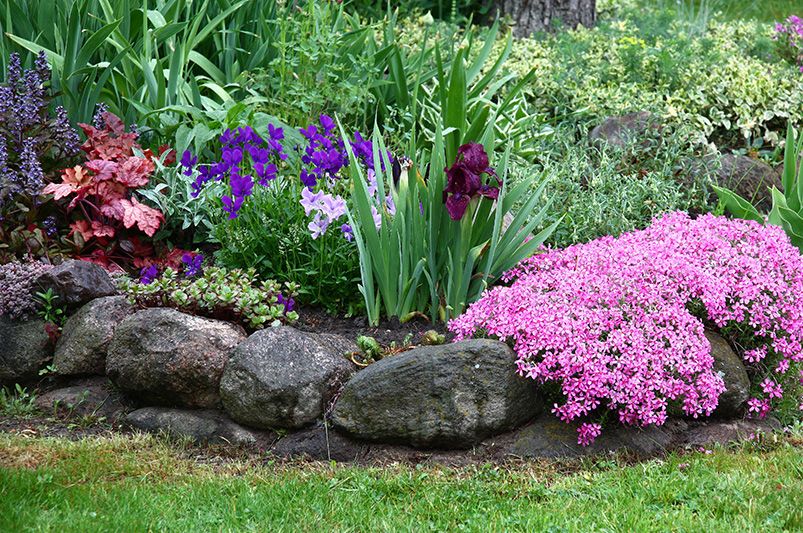
Phlox
Phlox is a vibrant and versatile perennial that works wonderfully in rain gardens due to its adaptability and visual appeal. Known for its clusters of brightly colored blooms in shades of pink, purple, white, and red, phlox adds a long-lasting splash of color from mid to late summer. This pollinator-friendly plant attracts butterflies, bees, and hummingbirds, supporting the local ecosystem. Phlox thrives in moist, well-drained soil and can tolerate occasional wet conditions, making it a great fit for the upper or middle zones of a rain garden. Its dense growth habit also helps prevent erosion, while its cheerful blooms bring beauty and biodiversity to your landscape.
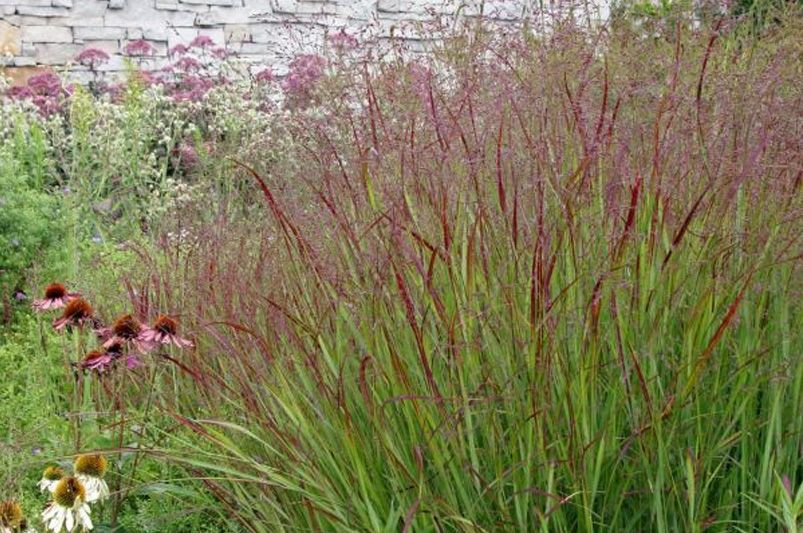
Switchgrass
Switchgrass is a native ornamental grass that’s both functional and attractive, making it an excellent addition to a rain garden. With its tall, upright form and airy, feathery plumes that appear in late summer, switchgrass adds texture, movement, and year-round interest to the landscape. Its deep, fibrous root system is especially valuable in rain gardens, as it helps absorb excess water, stabilize soil, and reduce erosion. Switchgrass is highly adaptable—tolerating both wet and dry conditions—and thrives in full sun. In addition to its structural beauty, it provides important habitat and food for birds and pollinators, making it a sustainable and eco-friendly choice for any rain garden design.
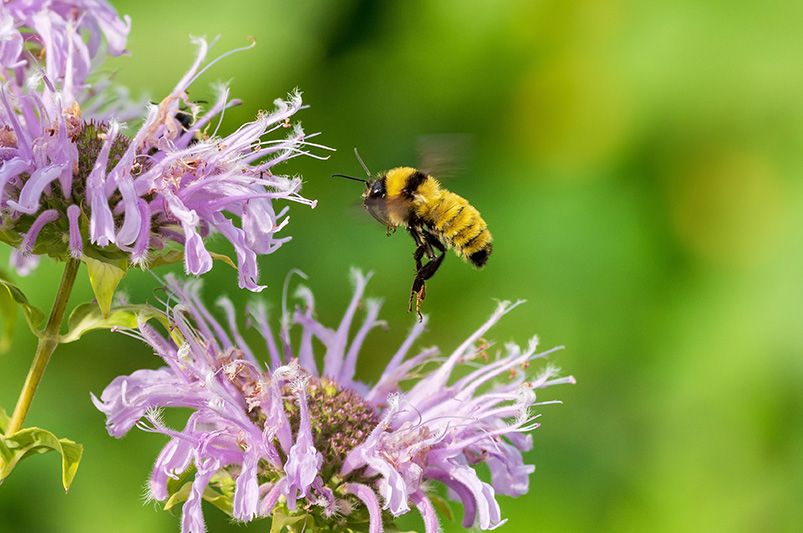
Bee Balm
Bee balm, also known as Monarda, is a standout choice for rain gardens thanks to its bold blooms, pollinator appeal, and love of moist soil. This native perennial produces vibrant, tubular flowers in shades of red, pink, purple, or white that bloom throughout the summer, attracting bees, butterflies, and hummingbirds in droves. Its fragrant foliage adds another layer of sensory interest and can even help deter deer. Bee balm thrives in the consistently moist conditions found in rain gardens, especially in the middle to upper zones. With its combination of beauty, ecological benefits, and adaptability, bee balm brings both color and life to any rain garden setting.
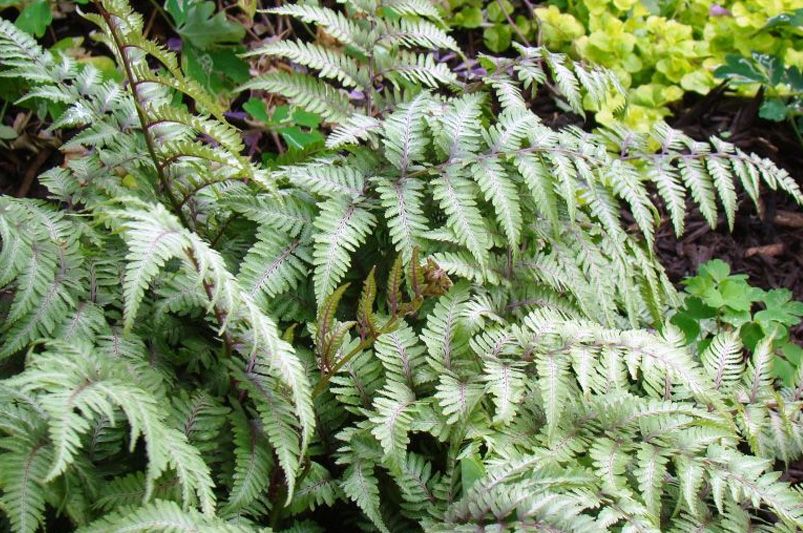
Japanese Painted Fern
The Japanese Painted Fern is a stunning addition to rain gardens, especially in shaded or partially shaded areas. Known for its elegant, silvery fronds brushed with shades of burgundy and green, this deciduous fern adds striking texture and color contrast to the landscape. It thrives in moist, well-drained soils and can tolerate the occasional wet conditions common in rain gardens. Ideal for the outer or upper edges of a rain garden, the Japanese Painted Fern complements other native plants while enhancing the garden’s visual appeal. Low-maintenance and deer-resistant, it’s a graceful, reliable choice for adding depth and beauty to shaded rain garden designs.
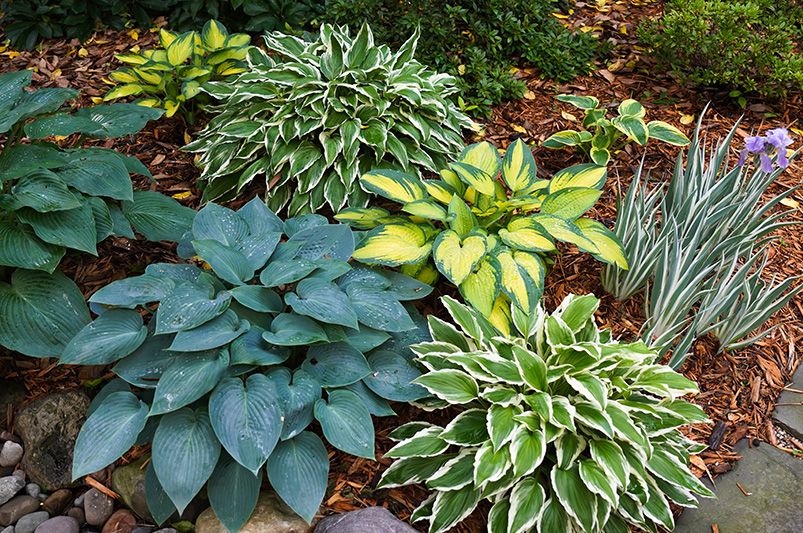
Hosta
Hostas are a popular and practical choice for rain gardens, especially in shaded or partially shaded areas. These hardy perennials are prized for their lush, broad leaves that come in a variety of colors and patterns—from deep green to vibrant chartreuse to variegated white and green. Hostas thrive in moist, well-drained soil and can handle the periodic wetness often found in rain garden environments. Their dense foliage helps suppress weeds and prevent soil erosion, making them both beautiful and functional. With their elegant texture, seasonal blooms, and low-maintenance nature, hostas are a reliable favorite for adding structure and charm to the shaded zones of a rain garden.
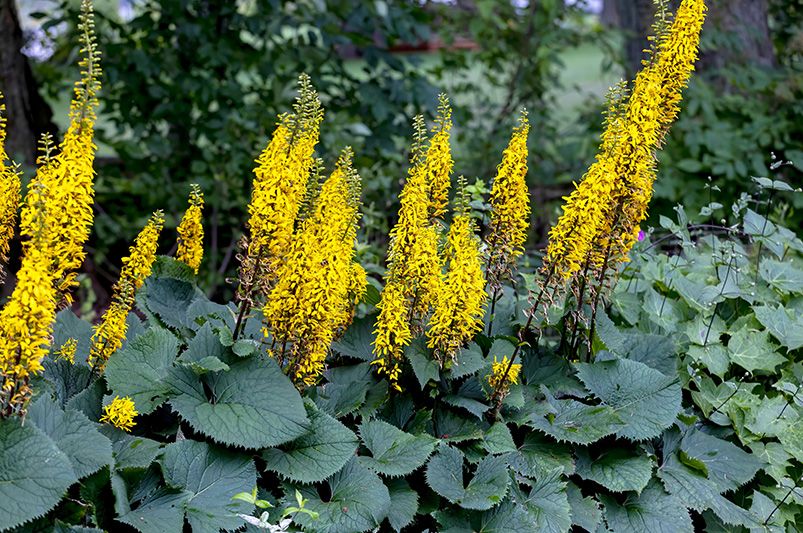
Ligularia
Ligularia is a bold, moisture-loving perennial that thrives in the damp, shady conditions often found in rain gardens. Known for its dramatic foliage—large, heart-shaped or serrated leaves in rich green or deep burgundy—and tall spikes or clusters of bright yellow or orange daisy-like flowers, ligularia adds both texture and vibrant color to the landscape. It performs best in consistently moist soil and partial shade, making it ideal for the lower or middle zones of a rain garden. In addition to its striking appearance, ligularia attracts pollinators and provides visual interest throughout the growing season. It’s a standout plant for gardeners looking to combine ornamental impact with ecological function.
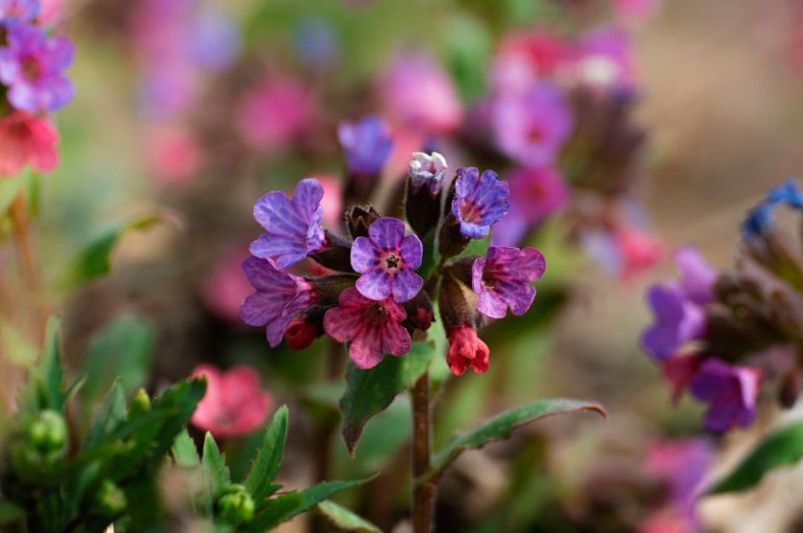
Lungwort
Lungwort (Pulmonaria) is a charming, shade-loving perennial that works beautifully in the upper edges of a rain garden. Valued for its unique, silver-speckled foliage and early spring blooms in shades of pink, blue, or violet, lungwort brings welcome color and texture to shaded, moist areas. It thrives in cool, damp conditions with well-drained soil, making it a natural fit for the less-saturated zones of a rain garden. In addition to its ornamental appeal, lungwort is deer-resistant and attracts early pollinators. Its low-growing, clumping habit also helps suppress weeds and stabilize soil, making it both functional and attractive in eco-friendly garden designs.
ShrubHub Tip: Browse our premium water-tolerant plant collections to find the perfect mix of colorful perennials, ornamental grasses, and native plants for your custom rain garden.
Maintenance Tips for Thriving Rain Gardens
One of the many benefits of rain gardens is that they require less long-term maintenance than traditional lawns or high-maintenance flower beds—especially when planted with hardy, native species. However, a little attention in the early stages will ensure your rain garden stays healthy, effective, and beautiful for years to come.
1. Seasonal Care: Keep Your Rain Garden Clean and Functional
-
Clear Debris: Regularly remove leaves, sticks, and other debris that may block water flow or clog planting areas.
-
Monitor Plant Health: Look for signs of disease, pests, or overcrowding, and address them promptly.
-
Prevent Soil Compaction: Avoid walking through the rain garden when the soil is wet to maintain proper drainage and soil structure.
2. Weed Management During Establishment
-
Rain gardens are especially vulnerable to weeds in their first year.
-
Keep an eye out for invasive species and pull weeds regularly to give your desirable plants the best chance to thrive.
-
Apply a thin layer of mulch to suppress weeds and help retain soil moisture during the critical early growth phase.
3. Minimal Maintenance Once Established
-
Once the plants are fully rooted (typically after the first growing season), your rain garden becomes largely self-sustaining.
-
Occasional weeding and seasonal cleanup are usually all that’s needed to keep it looking great and functioning efficiently.
-
Native, deep-rooted plants are naturally adapted to your climate and rarely need additional watering or fertilizing.
ShrubHub Tip: Our custom 3D landscape designs can help you plan a low-maintenance rain garden with plant combinations specifically chosen for long-term success in your region.
Conclusion:
Rain gardens are a smart, eco-conscious solution for homeowners looking to manage stormwater beautifully and efficiently. They not only help protect the environment by reducing runoff, erosion, and pollution, but they also bring vibrant plant life and year-round interest to your landscape.
With thoughtful design, proper plant selection, and minimal maintenance, your rain garden can become a functional centerpiece that supports local wildlife, improves drainage, and enhances curb appeal.
At ShrubHub, we’re passionate about creating outdoor spaces that are as sustainable as they are stunning. Our custom 3D landscape design services can help you build the perfect rain garden, tailored to your property’s layout, local climate, and personal style.


